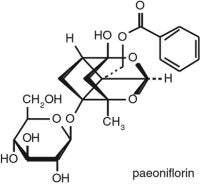Paeoniflorin: 
- Is Anti-inflammatory
- Reduces itchiness
- Is Antibacterial
- Soothes and moisturizes
- Promotes natural healing
Callaghan Innovation have conducted a systematic review (Paeony Literature Search) for Pure Peony and found “there is a large body of work to support the anti-inflammatory usage and action of paeony extracts.” (July 2018). The WHO notes that “The primary pharmacological effects of Radix Paeoniae are antispasmodic, anti-inflammatory, and analgesic. The major active constituent of the drug, paeoniflorin, a monoterpenoid glycoside, has sedative, analgesic, antipyretic, anti-inflammatory and vasodilatory effects in vivo” – Essential Medicines and Health Information Products Information Portal.
While traditionally taken orally there is both scientific studies and our anecdotal customer experience showing efficacy of topical anti-inflammatory use.
Prieto 2003 shows Paeonia lactiflora when used to treat topical inflammations shows inhibition of a marker linked to COX activity (inflammation pathway): Prieto, J. M., et al. (2003). "Influence of traditional Chinese anti-inflammatory medicinal plants on leukocyte and platelet functions." Journal of Pharmacy and Pharmacology 55(9): 1275-1282.
Chen 2011 and 2014 shows Peoniflorin reduced cytokine production (signaling molecules that mediate and regulate immunity and inflammation)) in human dermal endothelial cells (skin tissue) and Choi 2015 shows Peony extract inhibits inflammation in inflamed human keratinocytes (the predominant cell type in the epidermis, the outermost layer of the skin).
Further studies in vivo studies show the therapeutical effects on chronic dermatitis-eczema including relieving of swelling Li, C. Y., et al. (2008), Sun 2015 and on ameliorating skin lesions and inflammation and Wang 2015 in reducing allergic dermatitis inflammation.
Callaghan note that “Possibly the most relevant article is a study: Jo, G. H., et al. (2018). Here the paeoniae root extract was applied topically with the conclusion that “Paeoniae radix alba root extract is suggested to reverse the immunological alterations and skin manifestations symptoms found in atopic dermatitis”.
You can read our customer reviews on how the range of Pure Peony products (cream, soap, shampoo and conditioner) are helping people with skin issues, including eczema, psoriasis, rosacea and dermatitis and dry, itchy or sensitive skin caused by allergies or treatments. A recent customer survey (May 2018) found that 94% of 134 respondents rated Pure Peony products more effective at calming irritated skin that other natural skincare products they had tried.
How Does it Work
Peony glucosides work to simultaneously suppress excessive harmful immune functions while also boosting calming immune components. This level of immune balancing is beyond what most products do as other products typically either boost or suppress immunity, not both at the same time.
Our Organic White Peony Root
Dove River Peonies, home of the Pure Peony range, is New Zealand’s first organic white peony root farm. We sustainably farm and guarantee the quality and traceability of our products as we manage the whole process from our organic peony patch through to our finished product range.
Our peony root is independently tested by the Cawthron Institute in Nelson to establish the paeoniflorin levels.
Our soil has been independently tested by Hills Laboratory to confirms our soil purity.
We sustainably harvest, wash, slice and dry our root organically on site.
All our products are 100% natural, use our peony root and don’t contain nasty chemicals or animal products and are free from animal testing.
White Peony is also known as:
Paeonia lactiflora, Bai Shao Yao, Peony root, and Chinese Peony.
Articles about uses and benefits of Paeoniflorin
Peony Root for Autoimmune Diseases – Psoriasis etc.
Safely Manage Autoimmune Diseases
Peony root for Arthritis inflamation
http://www.evenbetterhealth.com/Rheumatoid-Arthritis-Pain.php
